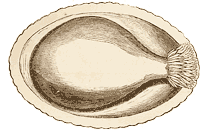If the ham be only three or four months old, there will be no occasion to soak it for any length of time, previously to its being cooked; but if, on the contrary, the ham happens to be of older standing, say upwards of a year old, it must be soaked for twenty-four hours at least, in cold water, before it will be really fit for cooking.

Ham Glazed with Spinach
When the ham has been sufficiently soaked, take it out of the water, scrape off the slime and dirt, saw off the knuckle, pare away all the rough exterior from the under part; and, having first sawed or merely chopped the pallet or broad part of the thigh-bone— just above the socket, remove this entirely.
This operation requires some care and dexterity; and, if the operation has to be performed by a woman, it had perhaps better be left undone, as, to my knowledge, ladies in general are nervous when handling a sharp knife under difficulties; besides, it is proper to state that, from the hardness of the ham, and the slipperiness of the bones, the operation is attended with danger.
Therefore, ladies, I would recommend that you should merely scrape and trim the ham, and put it in a large pan or pot with enough cold water to make it swim. Add a couple of carrots, onions, celery, a dozen cloves, mace, thyme and bay-leaves, and boil the ham very slowly indeed for about four or five hours, according to size and. weight: and when the ham is done, allow it to become cold in its own liquor.
When cold, remove the rind by gently slipping the ends of the fingers of both hands under the rind of the round thick end of the ham, and by this means detach it gradually without removing any of the fat. Trim the surface of the fat smoothly with a knife, place it on a baking-sheet in the oven for ten minutes, take it out, dab it over with a clean cloth to absorb all grease, and with a paste-brush dipped in liquid glaze, paint it all over to give it a uniform bright aspect. When thoroughly cold, garnish with aspic jelly or picked parsley.
Note.—A more economical way of finishing a cold ham is to shake some raspings all over the fat, instead of glazing it, and to decorate it all round the edge of the fat with a broad streak or band of chopped parsley, pressed on with the fingers and thumb. I need hardly add that, when a ham is required to be eaten hot, after being trimmed, it must be placed in a baking-dish covered over with its rind, or greased paper: add just enough of its own liquor to reach up to the edge of the fat, made hot in the oven for about half an hour, and glazed, and garnished with Jardiniere, Macedoine, spinach, broad beans, green peas, French beans, Brussels sprouts, &c.
